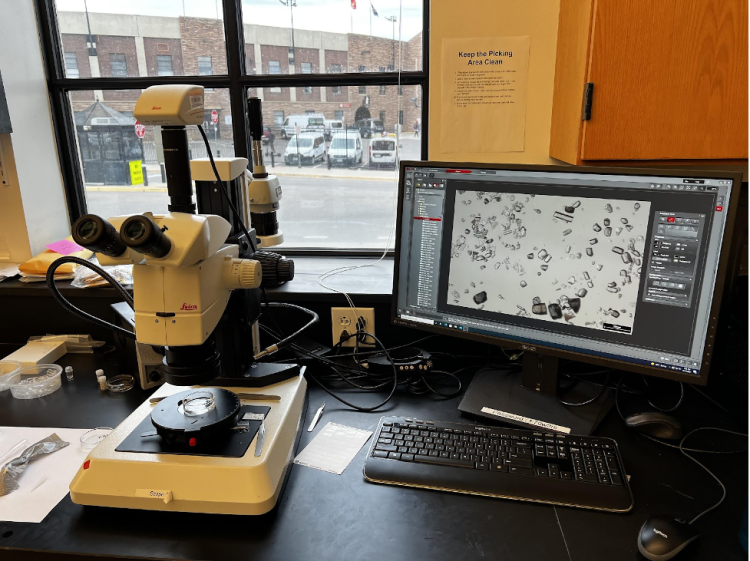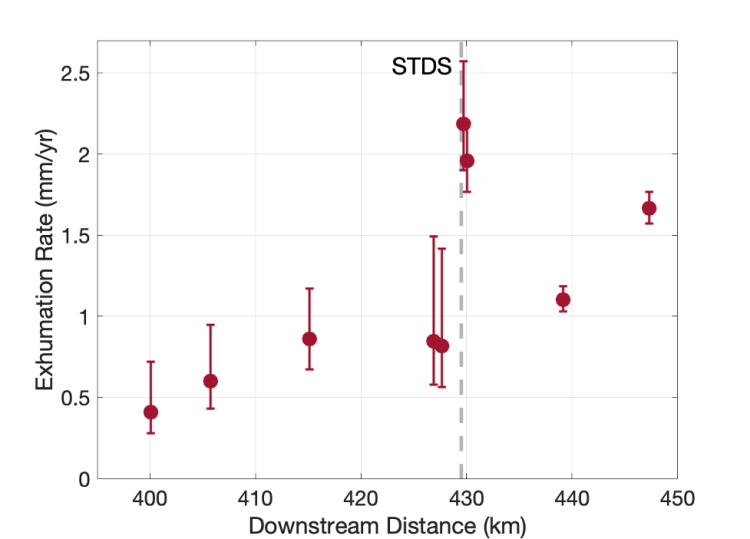Brian Penserini - Project Profile
2021 AGeS awardee
Lab: CU TRaIL (Thermochronology Research and Instrumentation Lab)
Lab Mentors: Becky Flowers and Jim Metcalf
What scientific question(s) does your research address and what motivates this work?
Existing apatite (U-Th)/He (AHe) ages from the Sutlej River valley in the Northwest Himalaya reveal a potential stepwise change in exhumation rate across the South Tibetan Detachment System (STDS), a system of north-dipping low-angle detachment faults that accommodated Miocene extrusion of the Himalayan crystalline core. This pattern of AHe ages appears to contradict the prevailing theory of an inactive STDS in this region since it is consistent with Quaternary activity along the STDS. However, locally enhanced incision resulting from large-scale drainage capture events in the Sutlej drainage network upstream of the STDS may also explain the observed pattern in AHe ages. These hypotheses are not mutually exclusive and current estimates of incision from numerical modeling along the Sutlej River are highly variable depending on which of these hypothetical mechanisms are considered. By obtaining additional AHe ages near the STDS, the region with the largest variation in modeled incision, I sought to improve constraints on recent exhumation patterns in a crucial reach of the Sutlej River and enable testing of multiple working hypotheses through comparisons with modeled incision.
What chronometric tool did you employ and why?
I used the AHe dating method since it permits estimation of exhumation rates of upper crustal rocks over timescales of ~105-107 years, which corresponds to the presumed timescale of the landscape response to river capture in our study area. AHe ages also allow us to estimate exhumation rates over time intervals that are not uniquely captured by other chronometers that have been used in the study area. This can lead to a more complete understanding of the exhumation history and improve constraints on temporal changes in exhumation rates.

Figure 1: Grain-picking setup at the CU TRaIL lab. A Leica M165 microscope is used to pick apatite grains, with additional help from a calibrated digital camera. Once suitable grains are picked, they are placed in Nb tubes for (U-Th)/He analysis.
What were some of the key takeaways of your research?
- Drainage capture alone cannot explain the observed pattern of exhumation revealed by AHe ages
- The close proximity (~2 km) between >1.7 Ma and <1.0 Ma AHe ages support the active STDS hypothesis
- These results are consistent with similar studies incorporating AHe ages across the STDS in the central Himalaya, implying models of Himalayan evolution must explain this pattern of recent exhumation along a large portion of the orogen

Exhumation rates inverted from AHe ages from the dataset along the Sutlej River. The STDS corresponds with the location of a ~2x increase in inferred exhumation rate crossing from the upstream hanging wall (lower downstream distance) to the downstream footwall (greater downstream distance). This pattern is consistent with Quaternary fault activity along the STDS.
What new experiences, opportunities, and collaborations did you gain as an AGeS-Grad awardee?
My research is typically not laboratory-based, so the AGeS program allowed me to gain laboratory experience that I wouldn’t have normally had. This led me to gain a greater appreciation for the analytical procedures that eventually result in the chronometric ages that I use in my research. Having these additional insights behind the methodology has helped me interpret published studies more critically and better understand what processes can influence AHe ages. The program has also allowed me to connect with geochronologists outside of my home institution and broaden my interests beyond the scope of my PhD work.
What is one piece of advice you have for future AGeS-Grad award applicants or awardees?
If you don’t get an award the first time you apply, don’t be discouraged from applying again. The review process can help you identify areas to improve your proposal, allowing you to make your application stronger for the next application cycle.

